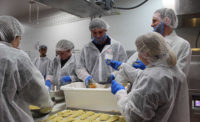Small meat processors are typically excellent people to get into catering. They know about food and food preparation, have access to most of the needed equipment and understand food safety.
To be successful in catering it is important to have a plan. Decide on the types of events you want to cater and the extent of the service you wish to provide. You want your catering activities to complement your existing business activities not conflict with them. You can get involved in either a big way or a small way.
It is essential that you decide the extent of service you want to provide your customers. Some caterers only prepare the food and require customers to pick it up at their facility, while other caterers take the food to the site and service everything from picnics to white tablecloth events.
Some of the different options you have are: meat only; meat plus homemade sides; meat plus commercially prepared sides; meat plus sides, dessert, drinks, plates, silverware, and napkins. If availability of labor is an issue, you may want to offer only meat and commercial sides picked up at your plant. Keep in mind that the catering customer is willing to pay you to perform certain tasks because they do not want to do them. Whatever the extent of service you provide, make sure your part is convenient and helpful for the customer.
There are many types of events that use caterers. There are one-time events such as; weddings, graduations, birthdays, anniversaries, holidays, company picnics and other special events. However, there is another often overlooked type of catering activity, the routine or repeat events such as; weekly meeting of a civic club, monthly national guard meetings or routine company meetings. I know of one company that hires a caterer to furnish breakfast to employees because they have found it boosts employee performance. Too many people were showing up for work having eaten nothing for breakfast that day.
When promoting your catering business, you and your employees are some of your best advertising. Make sure whatever you do, it is professional. The food should not only taste good but it should also look good. If you do on-site catering have your servers dress neatly and instruct them to be friendly and courteous. Keep in mind that everyone attending an event that you cater is a potential customer.
I know of one meat plant that arrives at a catering event in a panel truck with their name on the outside. The truck is equipped with chrome wheels and looks great (always clean). Inside the truck there are the catering supplies, tables for serving and a sink with running water. You don’t need to be that fancy, but do avoid the other extreme; an employee wearing a dirty t-shirt and driving a dirty pickup truck.
If you do on-site catering make sure you have a prior understanding of what happens to the leftovers. Do you take them or do they stay? If they stay, make sure they can be handled properly from a food safety standpoint. I know of some caterers that provide their customers with containers to use for leftovers.
Remember: Act quickly, think slowly.




Report Abusive Comment